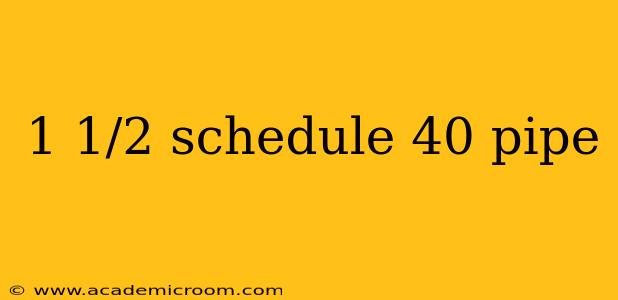Understanding pipe specifications can feel like navigating a foreign language, especially when you're faced with terms like "1 1/2 Schedule 40 pipe." This seemingly simple phrase actually packs a lot of information, describing crucial aspects of the pipe's dimensions and pressure capabilities. This comprehensive guide will break down exactly what "1 1/2 Schedule 40 pipe" means and answer common questions surrounding this widely used type of pipe.
What Does 1 1/2 Schedule 40 Pipe Mean?
The term "1 1/2 Schedule 40 pipe" refers to a specific type of steel pipe used in various applications, from plumbing to industrial processes. Let's dissect the components:
-
1 1/2: This indicates the pipe's nominal diameter. This is not the exact inside diameter (ID) or outside diameter (OD), but a standard size designation. The actual dimensions will vary slightly depending on the pipe's material and schedule.
-
Schedule 40: This refers to the pipe's wall thickness. Schedule 40 is a common standard for general-purpose applications, offering a balance between strength and cost. Higher schedule numbers indicate thicker walls and greater pressure resistance.
What are the Dimensions of 1 1/2 Schedule 40 Pipe?
While the nominal diameter is 1 1/2 inches, the actual dimensions are as follows:
- Outside Diameter (OD): Approximately 1.9 inches
- Inside Diameter (ID): Approximately 1.61 inches
- Wall Thickness: Approximately 0.109 inches (varies slightly depending on the manufacturer)
It's crucial to understand that these are approximate dimensions. Always refer to the manufacturer's specifications for precise measurements.
What is Schedule 40 Pipe Used For?
Schedule 40 pipe's versatility makes it suitable for a wide range of applications, including:
- Plumbing Systems: Carrying water, drainage, and other fluids in residential and commercial buildings.
- Industrial Processes: Transporting various liquids and gases in manufacturing plants and other industrial settings.
- Irrigation Systems: Delivering water to crops and landscaping.
- Fire Protection Systems: In some instances, depending on the system pressure requirements.
What is the Pressure Rating of 1 1/2 Schedule 40 Pipe?
The pressure rating of 1 1/2 Schedule 40 pipe depends on the fluid being transported and the temperature. The pressure rating is not a fixed value but is determined by considering factors such as the material, temperature, and safety factors. Consult relevant pressure rating charts provided by pipe manufacturers or engineering standards (like ASME B31.1) for accurate information.
How Does Schedule 40 Compare to Other Schedules?
Schedule 40 is a common choice, but other schedules exist, each with its own wall thickness and pressure capabilities:
- Schedule 10: Thinner walls, lower pressure rating, lighter weight, and less expensive.
- Schedule 80: Thicker walls than Schedule 40, higher pressure rating, better for high-pressure applications.
- Schedule 160: Very thick walls, extremely high pressure rating, used in demanding applications.
Choosing the correct schedule depends on the specific application and pressure requirements. Using a lower schedule than needed could compromise safety, while using a higher schedule might be unnecessarily expensive.
What are the Different Materials Used for 1 1/2 Schedule 40 Pipe?
While the term often implies steel, 1 1/2 inch diameter pipe can be made from various materials, each suited for different applications. Common materials include:
- Steel: Strong, durable, and suitable for high-pressure applications.
- PVC (Polyvinyl Chloride): Lightweight, corrosion-resistant, and often used in plumbing applications.
- CPVC (Chlorinated Polyvinyl Chloride): Similar to PVC but with higher temperature and pressure resistance.
- Copper: Corrosion-resistant and commonly used in plumbing for hot and cold water lines.
Selecting the appropriate material is critical for ensuring the pipe's longevity and performance within the specific application.
This detailed guide provides a thorough understanding of 1 1/2 Schedule 40 pipe. Remember to always consult manufacturer specifications and relevant engineering standards for precise information to ensure safe and effective application. Improper pipe selection can lead to leaks, failures, and potentially serious consequences.
